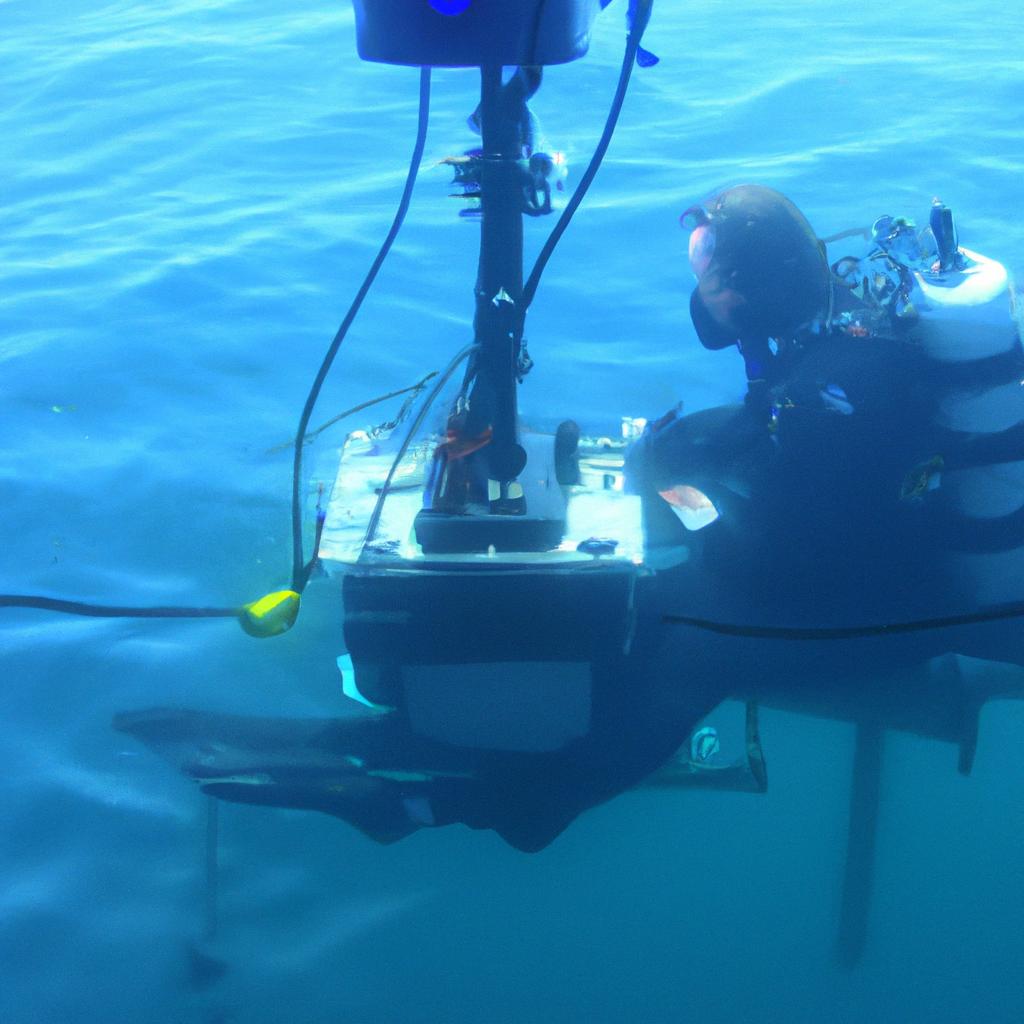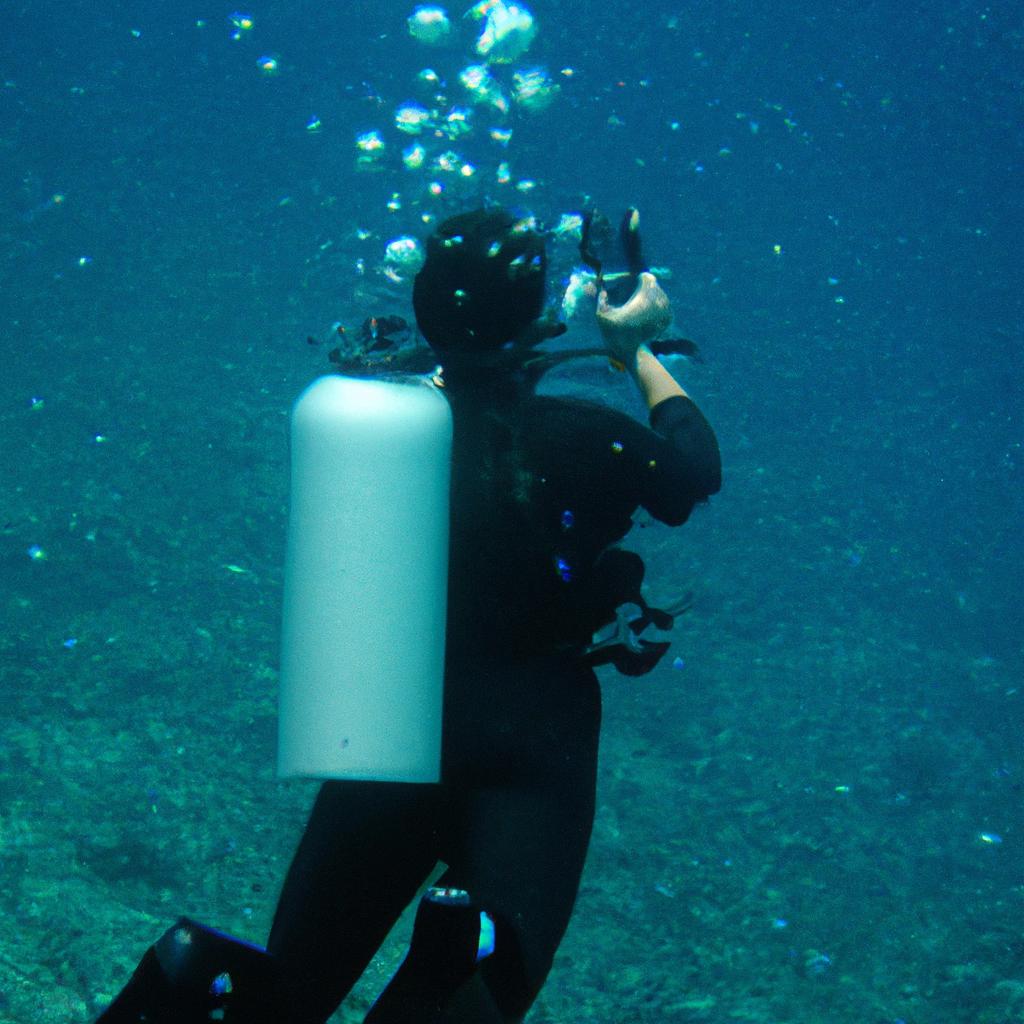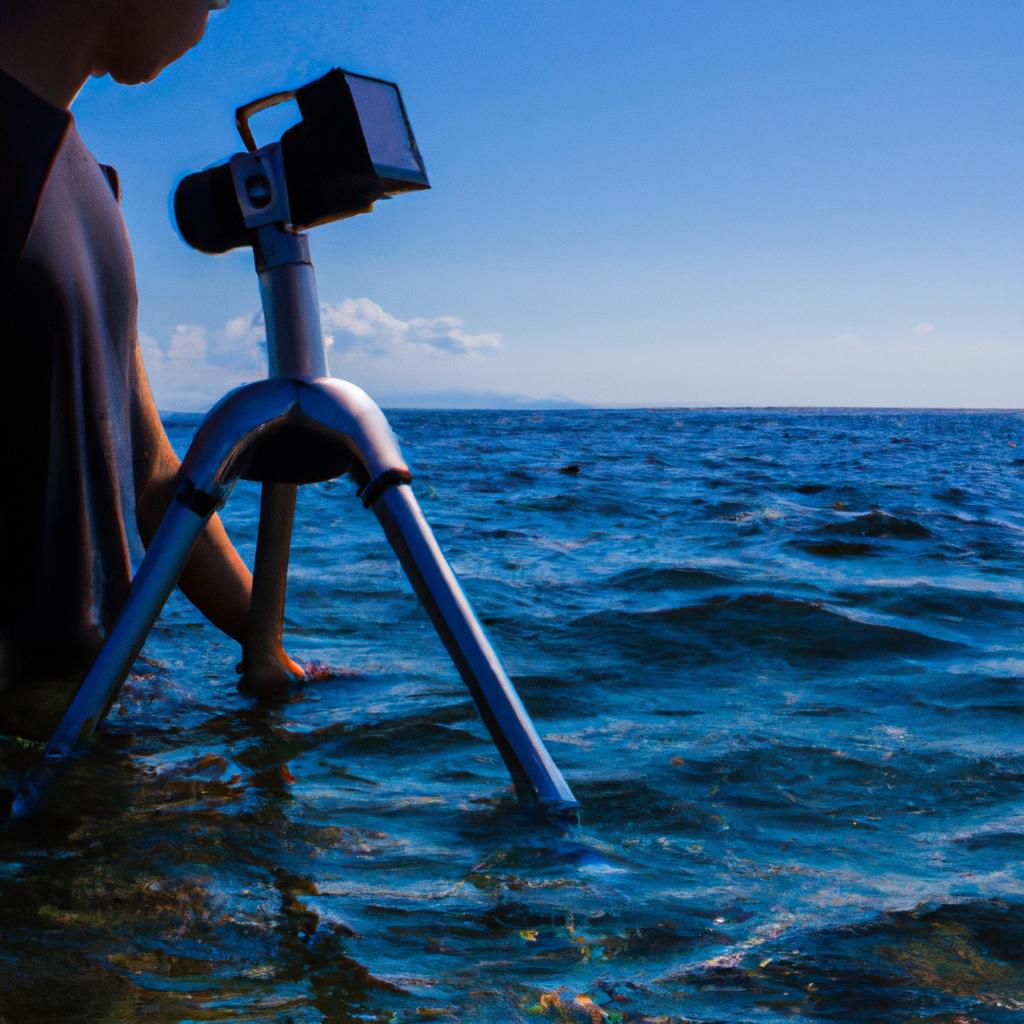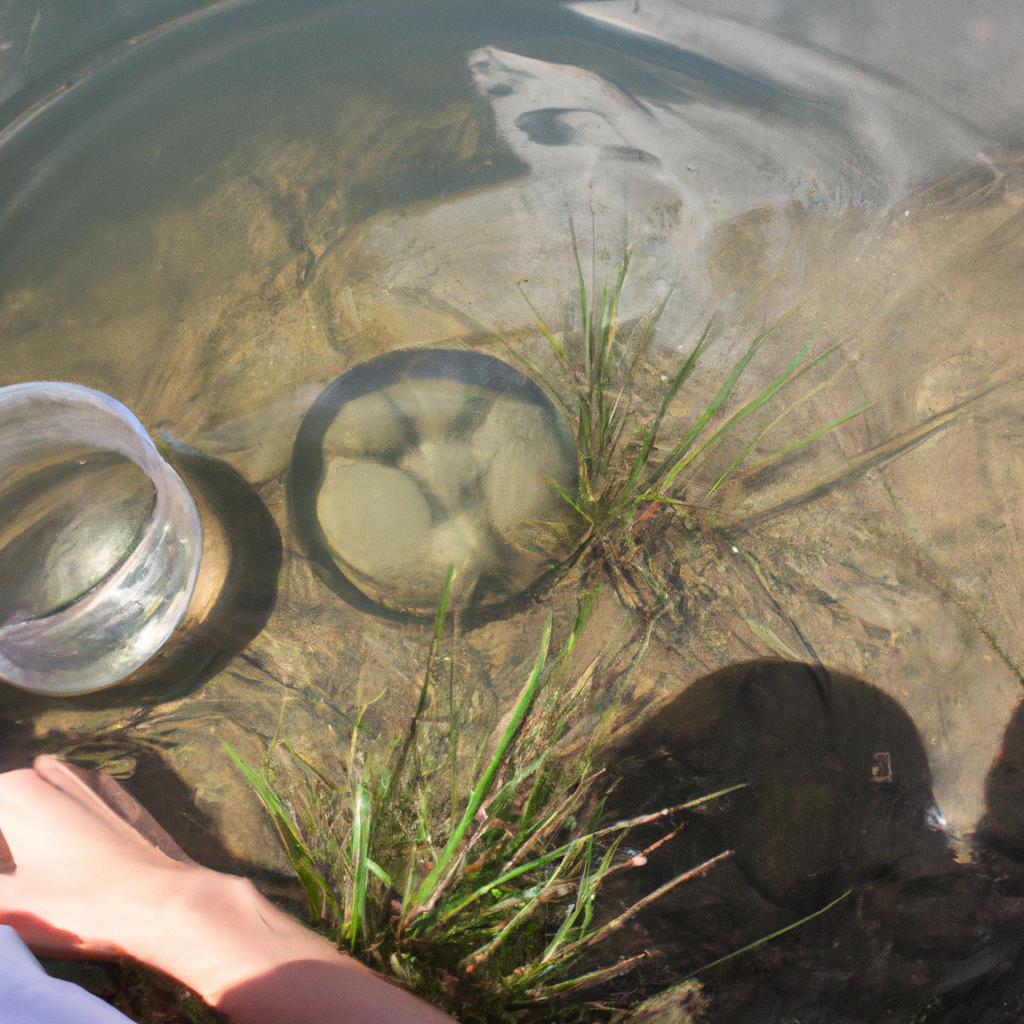The depletion of fish stocks in recent years has raised concerns about the sustainability of fisheries worldwide. As a result, there is an increasing need for interdisciplinary research to understand and address the complex dynamics of fisheries from various scientific perspectives. In this article, we explore the role of oceanography in the study of fisheries, focusing on its contribution to understanding marine ecosystems, population dynamics, and sustainable management strategies.
One example that highlights the significance of integrating oceanography into fisheries research is the case study of the California Current System (CCS). The CCS is a highly productive upwelling ecosystem off the western coast of North America known for its diverse fish populations. By examining physical and biological processes within this system, oceanographers have been able to elucidate key factors influencing fish abundance and distribution patterns. This knowledge has not only provided valuable insights into natural variability in fish populations but has also informed effective conservation measures and adaptive management strategies to sustainably exploit these resources.
The integration of oceanographic principles with fisheries science offers a comprehensive approach towards understanding the intricate relationship between marine environments and fishing activities. Through studying oceanographic processes such as currents, temperature gradients, nutrient availability, and primary productivity, researchers can gain insight into how these variables influence fish growth rates, reproduction cycles, migration patterns, and overall population dynamics. For example, oceanographers can analyze the effects of upwelling events on nutrient availability and primary productivity, which are crucial factors for fish food sources. By understanding how these processes vary spatially and temporally, scientists can identify areas of high productivity that support healthy fish populations.
Furthermore, oceanography plays a vital role in studying larval dispersal and connectivity within marine ecosystems. Ocean currents can transport larvae over long distances, affecting their survival and recruitment to adult populations. By tracking oceanographic features such as eddies and frontal systems, researchers can determine potential larval transport pathways and better understand population connectivity between different regions. This information is essential for developing effective fisheries management strategies that consider not only local stocks but also broader ecosystem dynamics.
In addition to understanding natural variability, oceanography contributes to sustainable fisheries management by assessing the impacts of human activities on marine ecosystems. For instance, it helps identify areas prone to hypoxia or oxygen depletion due to nutrient runoff from agricultural practices or pollution. These oxygen-deprived zones can have detrimental effects on fish populations by reducing their habitat suitability and increasing mortality rates. By monitoring oceanographic indicators of hypoxia, scientists can recommend measures to mitigate its occurrence and protect vulnerable species.
Overall, integrating oceanography into fisheries research enhances our understanding of marine ecosystems’ complexity and provides valuable insights into sustainable management strategies. By examining physical processes, nutrient availability, larval dispersal patterns, and environmental impacts, researchers can make informed decisions to conserve fish stocks while maximizing economic benefits for coastal communities. This interdisciplinary approach strengthens our ability to address the challenges posed by depleting fish stocks and ensures a more sustainable future for fisheries worldwide.
Importance of Fisheries in Earth Sciences
Importance of Fisheries in Earth Sciences
Fisheries play a vital role in the field of Earth sciences, as they provide valuable insights into the dynamics and health of marine ecosystems. By studying fisheries, scientists can gain a better understanding of the interactions between various components of the ocean environment, including water chemistry, physical processes, and biological communities. This section will highlight the significance of fisheries research from an oceanography perspective.
To illustrate this importance, let us consider a hypothetical case study involving a decline in fish populations off the coast of a small island community. Through careful analysis of catch data, researchers discovered that overfishing was occurring due to inadequate management practices. This finding prompted the implementation of stricter regulations and resulted in the gradual recovery of fish stocks—a clear demonstration of how fisheries science contributes to sustainable resource management.
- Fisheries research provides critical information on species abundance, distribution patterns, and population trends.
- It helps assess the impact of environmental changes such as climate variability and pollution on aquatic ecosystems.
- The study of fish behavior and migration patterns aids in understanding ocean currents and circulation systems.
- Fisheries studies contribute to the development of effective conservation strategies for threatened or endangered species.
Additionally, incorporating a table allows for concise presentation and comparison of key findings related to different aspects within fisheries research:
| Aspect | Key Findings |
|---|---|
| Population Dynamics | Overfishing is responsible for declines in several commercially important species. |
| Ecosystem Health | Fishery closures have shown positive effects on overall ecosystem biodiversity. |
| Climate Change Impact | Rising sea temperatures affect migratory patterns and reproductive success rates. |
| Management Practices | Effective quota allocation leads to increased economic benefits while ensuring sustainability. |
In conclusion, fisheries are invaluable tools for studying marine ecosystems from an earth science perspective. Their contribution extends beyond understanding fish populations; fisheries research provides insights into environmental changes, ocean dynamics, and the development of sustainable management practices. This knowledge is essential for addressing current challenges in fisheries management, as explored in the subsequent section.
Next Section: Current Challenges in Fisheries Management
Current Challenges in Fisheries Management
From understanding the importance of fisheries in Earth sciences, we now turn our attention to the current challenges faced by fisheries management. To illustrate these challenges, let us consider a hypothetical case study of a coastal community heavily reliant on fishing as their primary livelihood.
In this hypothetical scenario, imagine a small fishing village located along the coast of an oceanographic hotspot. For generations, the villagers have relied on abundant fish stocks for sustenance and economic prosperity. However, in recent years, they have noticed a decline in fish populations and are experiencing difficulties in sustaining their way of life.
This case study highlights some key challenges that many fisheries face today:
- Overfishing: Overexploitation of fish stocks due to increasing demand has led to unsustainable harvest rates. This results in depleted populations and disrupts ecosystem dynamics.
- Habitat degradation: Human activities such as pollution, destructive fishing practices, and coastal development can degrade critical habitats like coral reefs or mangroves that serve as breeding grounds or nurseries for various fish species.
- Climate change impacts: Rising sea temperatures, ocean acidification, and changes in currents and upwelling patterns affect the distribution and abundance of marine species. These climate-related factors pose significant threats to fisheries worldwide.
- Poor governance and management practices: Inadequate regulations, lack of enforcement, ineffective monitoring systems, and limited access to scientific data all contribute to poor fisheries management strategies.
To emphasize the urgency of addressing these challenges, let us examine a table showcasing the consequences if no action is taken:
| Consequences |
|---|
| Declining fish stocks |
| Loss of biodiversity |
| Economic instability |
| Food insecurity |
The alarming reality portrayed in this table underscores the need for immediate action towards sustainable fisheries management.
As we delve into subsequent sections discussing the impact of climate change on fisheries, it becomes apparent that addressing these prevailing challenges is crucial not only for ecological preservation but also for the socio-economic stability of coastal communities. It is imperative that we explore innovative solutions and implement effective management strategies to ensure the long-term viability of our fisheries resources.
Impact of Climate Change on Fisheries
Building on the understanding of current challenges in fisheries management, this section delves into the impact of climate change on fisheries. By exploring this critical aspect through an oceanography perspective, we can better comprehend how changing environmental conditions are shaping the future of our marine resources.
The effects of climate change on fisheries are already being witnessed worldwide. For instance, let’s consider a hypothetical scenario where rising sea temperatures have led to significant changes in the distribution and abundance of key fish species along coastal regions. This shift has resulted in economic losses for local fishing communities that heavily rely on these species for sustenance and livelihoods.
To gain a deeper insight into the complexities surrounding climate change and its influence on fisheries, several key factors must be considered:
- Ocean acidification: As carbon dioxide levels increase in the atmosphere, excess CO2 is absorbed by seawater. This process leads to ocean acidification, which negatively impacts shell-forming organisms like mollusks and crustaceans at various stages of their life cycles.
- Changes in planktonic productivity: Plankton forms the foundation of marine food webs, serving as a vital source of nutrition for many fish species. Alterations in water temperature and nutrient availability directly affect planktonic productivity, potentially leading to cascading effects throughout the entire ecosystem.
- Shifts in migratory patterns: The warming oceans can cause shifts in migratory routes and timing for certain fish populations. These alterations disrupt traditional spawning grounds and migration corridors, making it challenging for both commercial and recreational fishermen to locate target species.
- Increased frequency of extreme weather events: Climate change intensifies extreme weather phenomena such as hurricanes or typhoons. These events can devastate coastal ecosystems, causing habitat destruction and disrupting breeding habitats essential for fish reproduction.
Table – Impacts of Climate Change on Fisheries
| Impacts | Consequences |
|---|---|
| Loss of biodiversity | Reduction in species abundance and diversity |
| Decline in catch yields | Economic losses for fishing industries |
| Altered fish behavior | Changes in feeding, migration, and reproduction patterns |
| Disruption of food webs | Imbalance within marine ecosystems |
It is evident that climate change poses significant challenges to the sustainability of fisheries worldwide. Adapting to these changes necessitates robust management strategies that account for evolving environmental conditions. By integrating scientific knowledge from oceanography into fisheries management practices, we can strive towards preserving our valuable fishery resources for future generations.
The exploration of fishery resources goes beyond understanding their vulnerability to climate change; it also involves identifying potential solutions and innovative approaches to ensure their sustainable utilization.
Exploration of Fishery Resources
Section H2: Exploration of Fishery Resources
Transitioning from the previous section on the impact of climate change on fisheries, we now delve into the exploration of fishery resources. To better understand this topic, let us consider a hypothetical case study involving a coastal community heavily reliant on small-scale fishing for their livelihoods. This community has noticed a decline in their catch over the past decade and seeks to explore new fishery resources to sustain their industry.
Exploring new fishery resources requires an understanding of various factors that influence the availability and productivity of marine ecosystems. Here are some key considerations:
-
Oceanographic Conditions: The physical properties of seawater such as temperature, salinity, and nutrient levels play a crucial role in supporting diverse fish communities. Understanding how these oceanographic conditions vary spatially and temporally can help identify potential areas with high fish abundance.
-
Habitat Suitability: Different species have specific habitat requirements for feeding, reproduction, and shelter. Exploring new fishery resources involves identifying suitable habitats based on factors like substrate type, water depth, current patterns, and presence of underwater structures such as reefs or seagrass beds.
-
Trophic Interactions: A complex web of interactions exists among different organisms within marine ecosystems. Examining trophic relationships between predators and prey is essential in identifying potential target species for exploitation while ensuring ecosystem balance.
-
Fishing Technologies: Advancements in fishing technologies have enabled more efficient identification and targeting of fish stocks. However, it is crucial to strike a balance between technological advancements and sustainable practices to avoid overexploitation or damaging impacts on non-target species and habitats.
To further illustrate the significance of exploring fishery resources systematically, consider Table 1 below which showcases examples of successful exploratory efforts in different regions:
Table 1: Examples of Successful Fishery Resource Exploration Efforts
| Gulf of Mexico | Red Snapper | Acoustic surveys and underwater cameras |
| South Africa | Abalone | Genetic analysis to identify suitable habitats |
| Baltic Sea | Herring | Satellite remote sensing for identifying optimal fishing grounds |
| Coral Triangle | Ornamental Fishes | Citizen science initiatives involving local communities |
By leveraging these exploration strategies, the coastal community in our hypothetical case study can discover new fishery resources that could potentially revitalize their industry. This highlights the importance of employing a holistic approach that combines scientific knowledge, technological advancements, and active community involvement.
Transitioning seamlessly into the subsequent section on sustainable practices in fisheries, we recognize the need not only to explore new resources but also to ensure their long-term viability. By adopting sustainable practices, we can strike a balance between exploiting fishery resources and preserving marine ecosystems for future generations.
Sustainable Practices in Fisheries
Section H2: Sustainable Practices in Fisheries
Transitioning from the exploration of fishery resources, it becomes imperative to delve into sustainable practices that can ensure the long-term viability and conservation of these valuable marine ecosystems. One such example is the case study of a small fishing community located on the coastlines of South East Asia. This community traditionally relied heavily on destructive fishing methods, resulting in declining fish populations and devastating impacts on their livelihoods. However, through the implementation of sustainable practices, including ecosystem-based management approaches and gear modifications, they were able to restore fish stocks, protect sensitive habitats, and secure a more prosperous future for both themselves and future generations.
To ascertain sustainability within fisheries management, several key strategies have been identified:
- Implementing catch quotas: By setting limits on how much fish can be harvested from specific areas or species at any given time, scientists and policymakers aim to prevent overfishing and allow depleted stocks to recover.
- Establishing marine protected areas (MPAs): These designated zones serve as sanctuaries where fishing activities are regulated or prohibited altogether. MPAs help safeguard critical habitats, enhance biodiversity, and promote natural replenishment of fish populations.
- Encouraging responsible aquaculture practices: The expansion of aquaculture has played a vital role in meeting global seafood demands; however, irresponsible farming techniques can lead to pollution, disease outbreaks among farmed fish, and negative interactions with wild populations. Promoting environmentally friendly practices ensures sustainable growth within this sector.
- Enhancing collaboration between stakeholders: Effective fisheries management requires close cooperation among governments, fishermen associations, environmental organizations, researchers, and local communities. Engaging all relevant parties fosters shared understanding and collective action towards achieving sustainable goals.
The table below highlights some potential benefits derived from implementing sustainable practices in fisheries:
| Benefits | Description |
|---|---|
| Increased fish populations | Sustainable fishing methods enable fish stocks to recover, leading to higher catch and yields. |
| Preservation of habitats | Protecting sensitive ecosystems ensures the preservation of critical breeding grounds for marine life. |
| Economic stability | Sustainable practices support long-term livelihoods and economic opportunities in fishing communities. |
| Enhanced food security | Maintaining healthy fish populations contributes to global efforts in ensuring a stable food supply. |
Looking ahead, it is crucial that we explore further advancements and innovative approaches towards sustainable fisheries management. This includes harnessing emerging technologies such as satellite monitoring systems, DNA-based identification techniques, and incorporating traditional ecological knowledge into decision-making processes. By continuously evaluating and adapting our strategies based on scientific research and local experiences, we can strive towards achieving a more harmonious balance between human needs and the conservation of precious ocean resources.
Transitioning into the subsequent section about “Future Directions for Fisheries Research,” ongoing studies are shedding light on promising avenues for advancing sustainability within this field.
Future Directions for Fisheries Research
The sustainable practices in fisheries are crucial for the long-term well-being and preservation of marine ecosystems. However, with the ongoing challenges posed by climate change, it is essential to understand how this global phenomenon affects fisheries from an oceanography perspective. This section will explore the impact of climate change on fisheries, highlighting both potential consequences and future directions for research.
One example that illustrates the influence of climate change on fisheries can be seen in the case study of a coastal community heavily reliant on fishing as its primary source of livelihood. As sea surface temperatures increase due to climate change, certain fish species may migrate or shift their distribution patterns, affecting local catches. This alteration in species composition not only disrupts established ecological relationships but also poses economic challenges for communities dependent on specific fish populations.
To comprehend the broader implications of climate change on fisheries, several key factors must be considered:
- Changing Ocean Circulation Patterns: Alterations in ocean currents driven by rising temperatures can significantly affect nutrient availability and productivity levels within marine environments.
- Ocean Acidification: Increased carbon dioxide absorption by seawater leads to acidification, which impacts shell-forming organisms such as mollusks and coral reefs.
- Intensified Storm Events: Changes in weather patterns associated with climate change result in more frequent and severe storms, leading to potential damage to fishing infrastructure and disruptions to fishing activities.
- Loss of Habitat Diversity: Rising sea levels linked to global warming contribute to coastal erosion and loss of critical habitats like mangroves and seagrass beds, impacting fish breeding grounds.
A comprehensive understanding of these complex interactions between climate change and fisheries requires continued research efforts. Scientists need to investigate alternative adaptation strategies that promote sustainability while accounting for changing environmental conditions. By combining field observations, experimental studies, modeling techniques, and interdisciplinary collaborations across various scientific fields, researchers aim to develop effective management approaches that mitigate negative impacts on both fisheries and coastal communities.
In summary, climate change poses significant challenges to fisheries worldwide. The example of a coastal community’s reliance on fishing showcased how shifts in species distribution can disrupt local economies. Understanding the broader impacts of climate change is crucial for effective management strategies. By considering changing ocean circulation patterns, ocean acidification, intensified storm events, and habitat loss, scientists strive to develop sustainable practices that ensure the continued well-being of both marine ecosystems and human societies.










